Gestion de Projet avec une Touche de Magie
Planifiez, pilotez et livrez vos projets efficacement. Merlin Project pour macOS et iOS
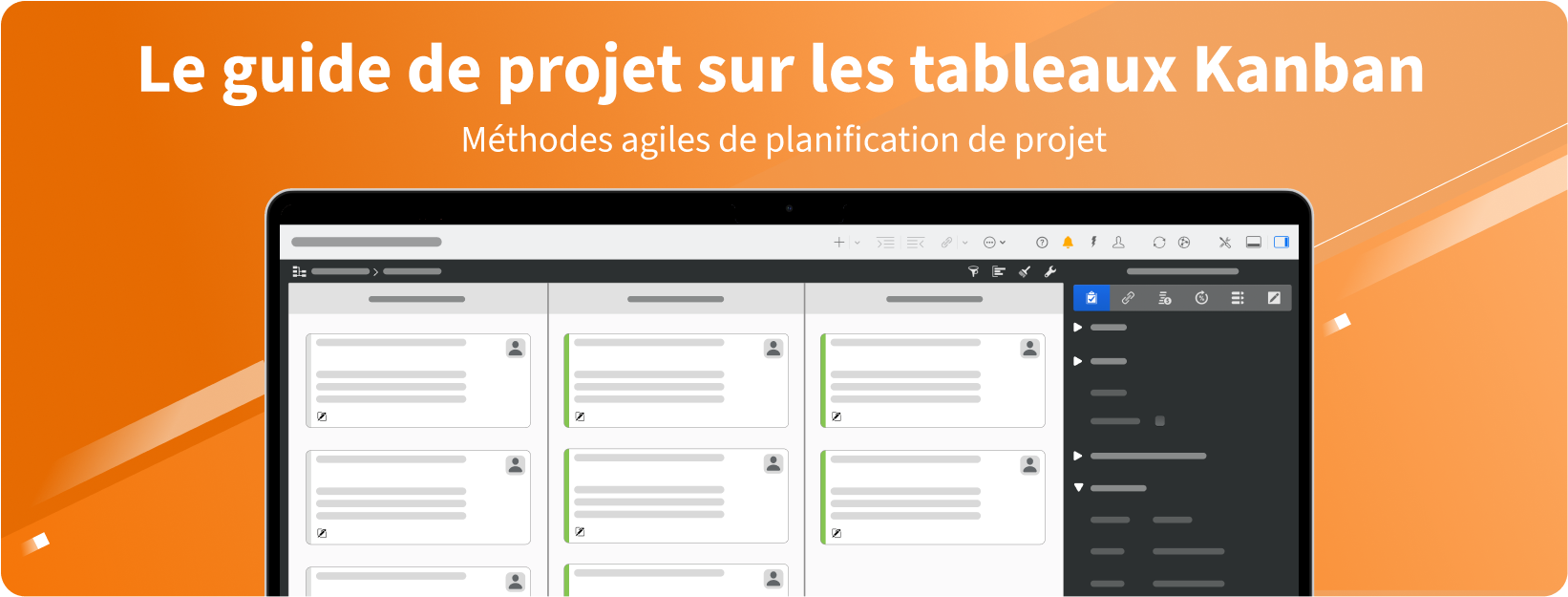
Dans ce guide, nous allons nous pencher sur la gestion de projet agile avec Kanban. Vous apprendrez à mettre en place votre propre tableau Kanban, étape par étape, et découvrirez des techniques clés pour gérer efficacement le flux de travail, limiter le travail en cours et rester adaptable lorsque les priorités changent. Plongeons dans l'aventure !
Table des matières
Introduction à Kanban
Origine et définition de Kanban
Les principes agiles qui sous-tendent Kanban
Comment mettre en œuvre Kanban : Guide étape par étape
Conseils et astuces
Cas d'utilisation de Kanban
La bonne boîte à outils pour Kanban
Gestion de projet agile avec Merlin Project
Dernières réflexions
Questions fréquemment posées
Imaginez que vous entriez dans une usine où chaque poste fonctionne comme une symphonie bien réglée : les pièces arrivent juste à temps, les produits finis sont emballés sans problème et les équipes s'adaptent presque en temps réel à l'évolution de la demande. Cette danse élégante est le résultat d'un système de gestion de projet connu sous le nom de Kanban. Né dans l'industrie automobile et largement adopté par les développeurs de logiciels et les professionnels de la création, Kanban permet de voir son travail, de contrôler le flux et d'optimiser en permanence la façon dont les tâches passent de « à faire » à « fait ».
La plupart d'entre nous ont entendu parler du terme VUCA. C'est presque devenu un mot à la mode. Cependant, notre monde est réellement Volatile (volatile), Uncertain (incertain), Complex (complexe) et Ambiguous (ambigu). Les échéances surgissent de nulle part, les priorités changent en un clin d'œil et les équipes dispersées à travers le monde ne font qu'ajouter au désordre. Les bouleversements technologiques rapides, les tendances changeantes du marché et les attentes en constante évolution des clients conspirent tous pour rendre notre vie professionnelle quotidienne imprévisible.
Le kanban permet de faire la part des choses. En rendant les tâches visibles et en limitant le travail en cours, il apporte clarté et concentration, ce qui vous aide à affronter le changement en toute confiance. Plus que des tableaux et des notes autocollantes, Kanban permet une amélioration continue, en maintenant les équipes flexibles, réactives et efficaces - sans l'épuisement professionnel.
Contrairement aux cadres rigides, Kanban est simple à mettre en œuvre - pas de changement de rôle, pas de sprints obligatoires, pas de planification lourde. Qu'il s'agisse d'équipes ou de travail en solo, ses repères visuels permettent d'organiser les tâches et de clarifier les progrès.

En production, nous devons gérer le flux, pas seulement les personnes.
Taiichi Ohno, père du système de production Toyota
Le Kanban trouve son origine dans le Japon de l'après-guerre, où Toyota cherchait à revitaliser son système de fabrication. Les ingénieurs de Toyota, dirigés par le pionnier de l'industrie Taiichi Ohno, se sont inspirés des supermarchés. Ils ont remarqué que les rayons n'étaient réapprovisionnés que lorsque les articles étaient presque épuisés - pas de gaspillage, pas de surproduction. Toyota a reproduit ce système « pull » dans ses usines en utilisant des signaux visuels appelés « cartes Kanban ». Ces cartes indiquaient quand un nouveau lot de composants était nécessaire, ce qui permettait d'éviter les surstocks et d'assurer un flux régulier.
Quelques décennies plus tard : En 2007, David Anderson, consultant en informatique, a adapté le système Kanban au travail de connaissance, tel que le développement de logiciels, les campagnes de marketing et les projets créatifs. Au lieu de pièces d'usine, les tâches ou les caractéristiques sont placées sur un tableau et progressent par étapes, ce qui permet aux équipes de ne s'attaquer qu'à un nombre limité d'éléments à la fois. Cette adaptation a fait monter en flèche la popularité de Kanban dans tous les secteurs d'activité.
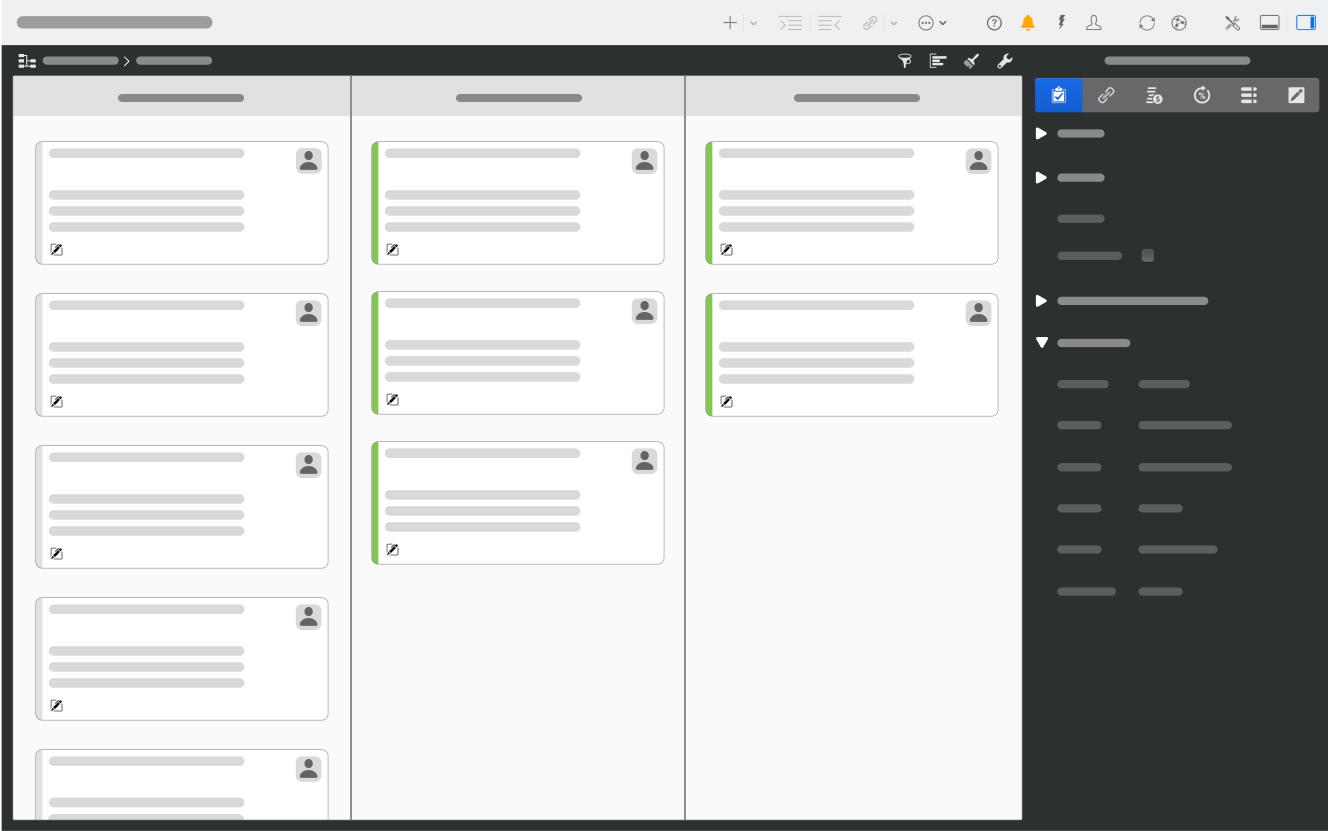
Qu'est-ce que Kanban exactement ? Le mot lui-même est japonais et signifie « panneau d'affichage » ou « enseigne ». Un tableau Kanban est un outil qui permet de visualiser le flux de travail, généralement divisé en colonnes telles que « À faire », « En cours » et « Terminé ». Chaque carte du tableau représente une tâche ou un élément de travail. Associé à d'autres pratiques fondamentales, telles que la limitation des travaux en cours (TEC) et l'amélioration continue, le Kanban devient un cadre souple et efficace.

Sans contrôle visuel, la confusion règne.
Taiichi Ohno
Kanban est considéré comme l'une des méthodologies agiles — une famille d'approches de gestion de projet qui mettent l'accent sur l'adaptabilité, l'apprentissage itératif et la collaboration. Alors que certaines méthodes agiles (comme Scrum) exigent de nouveaux rôles et de nouvelles cérémonies, Kanban penche en faveur d'un changement évolutif. Vous commencez par votre flux de travail actuel, vous le visualisez, puis vous affinez progressivement la façon dont le travail se déplace au sein de votre équipe ou de votre service.
Au cœur de Kanban se trouve l'idée que les êtres humains saisissent l'information beaucoup plus efficacement lorsqu'elle est visuelle. (Pensez à la différence entre une liste de tâches compliquée et textuelle et un tableau clair et codé par couleur). En traçant le parcours de chaque tâche du début à la fin, Kanban révèle les goulets d'étranglement, les problèmes de capacité ou le manque de clarté de l'appropriation.
Les équipes découvrent souvent que les tâches sont bloquées en « Révision » ou en « Attente des commentaires du client ». Avec Kanban, ces blocages ne peuvent pas se cacher dans un système opaque. Ils sont présents sur le tableau, ce qui facilite leur résolution. Cette approche basée sur le flux signifie que les tâches ne restent pas indéfiniment bloquées dans une seule colonne, et que votre travail progresse à un rythme régulier et prévisible.
Limiter les travaux en cours (TEC)
Kanban remet en question le mythe populaire du « multitâche » en limitant le nombre de tâches sur lesquelles vous pouvez travailler en même temps. Cette limite oblige les équipes et les individus à terminer les tâches avant d'en ajouter de nouvelles. Le résultat ? Moins de tâches à moitié accomplies et des délais d'exécution plus courts.
Amélioration continue
Kanban encourage les ajustements progressifs plutôt que les changements radicaux et perturbateurs. Au lieu de revoir l'ensemble de votre flux de travail, vous observez votre tableau chaque jour ou chaque semaine, vous expérimentez de petites améliorations et vous mesurez les résultats. Au fil du temps, ces petites améliorations s'accumulent et se traduisent par des gains de productivité importants.
Flexibilité du processus
Kanban ne dit pas qu'il faut tenir des réunions quotidiennes ou adhérer à des sprints fixes. Si les exigences d'une tâche changent en cours de route, vous pouvez vous adapter sans interrompre le sprint. Cette flexibilité est particulièrement précieuse dans les environnements où la livraison continue ou les demandes imprévisibles des clients sont la norme.
Autonomie de l'équipe
Parce que les tâches sont tirées plutôt que poussées, les membres de l'équipe sont autonomes dans la façon dont ils choisissent et abordent les tâches. Cela permet de mettre l'accent sur un style d'auto-organisation, en s'alignant sur le principe agile plus large selon lequel ceux qui font le travail sont les mieux placés pour décider de la façon dont il est fait.

Kanban est une méthode qui permet d'accomplir un travail en limitant les travaux en cours et en gérant les flux. J'ai constaté que certains travaux (en particulier les travaux créatifs) sont gérés plus efficacement avec des itérations, tandis que d'autres travaux (en particulier les travaux naturellement séquentiels) sont gérés plus naturellement avec Kanban.
Mary Poppendieck, pionnière du logiciel Lean
| Avantages | Inconvénients |
|---|---|
| La charge de gestion est réduite et la vitesse de réalisation augmente | Les membres de l’équipe doivent disposer de compétences qui se chevauchent pour éviter les goulots d’étranglement quand certains employés sont déjà pleinement occupés |
| Kanban peut être utilisé avec des méthodes de gestion aussi bien traditionnelles qu’agiles | Kanban ne fonctionne que si les lots de travail peuvent être clairement subdivisés en étapes de tâches distinctes |
| Des sprints courts permettent de détecter rapidement les éventuelles erreurs d’orientation | Les projets avec une date butoir fixe sont mieux gérés avec Scrum ou TPM, car ils accordent une plus grande importance à la gestion du temps |
| Motivation accrue, car les équipes travaillent de manière plus autonome et les membres choisissent eux-mêmes leurs tâches dans le pool | – |
Désireux d'essayer Kanban dans le cadre de votre prochain projet ? Voici une feuille de route simple :
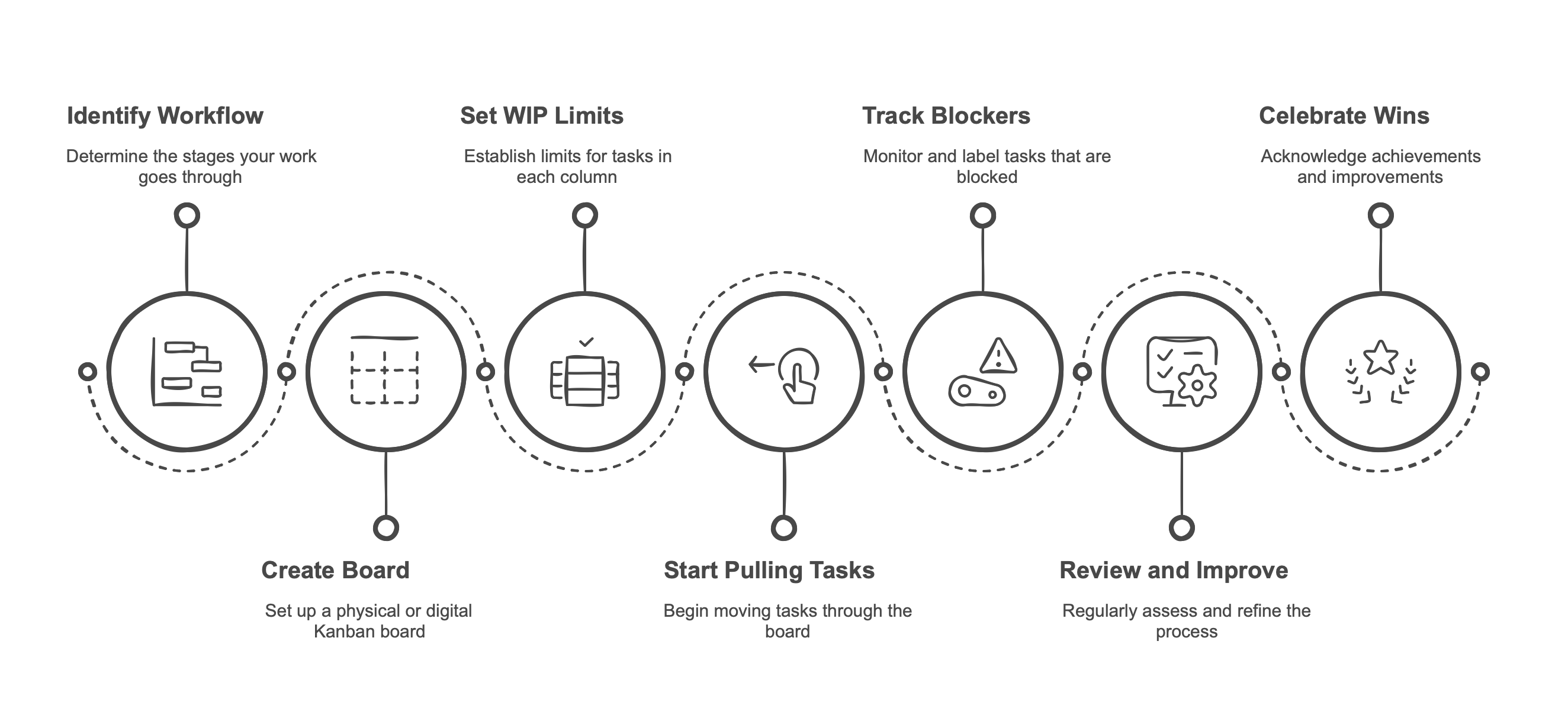
Identifiez votre flux de travail
Notez les étapes par lesquelles votre travail passe naturellement. Un flux simple peut être Backlog → Doing → Done. Les flux de travail complexes peuvent comporter des étapes telles que Conception → Développement → Test → Déploiement. Restez minimal au début ; vous pourrez toujours ajouter d'autres colonnes par la suite.
Créer votre tableau
Choisissez un tableau blanc physique ou un outil numérique - selon le style de votre équipe. Étiquetez les colonnes pour représenter chaque étape. Placez des notes autocollantes (ou des cartes numériques) sur le tableau pour chaque tâche. Une carte = une tâche (ou une histoire d'utilisateur, une fonction, etc.).
Fixer des limites d'encours (TEC)
Déterminez le nombre de tâches qui peuvent se trouver simultanément dans chaque colonne. Par exemple, fixez une limite de 3 tâches dans la colonne « Développement ». Si vous atteignez cette limite, vous ne pouvez pas ajouter de nouvelles tâches jusqu'à ce que l'une d'entre elles progresse. Cette règle d'or vous permet de rester concentré et d'éviter la redoutable accumulation de tâches à moitié terminées.
Commencez à retirer des tâches
Commencez à travailler sur les tâches de la colonne la plus à gauche. Lorsque vous avez terminé, déplacez la carte à l'étape suivante. Ce n'est qu'à ce moment-là que vous en tirez une nouvelle de la colonne de gauche. Ce système de tirage favorise un flux sain, évitant que votre tableau ne devienne un désordre chaotique « tout est en cours ».
Tracer les blocages et surveiller le flux
Chaque fois qu'une tâche est bloquée, indiquez qu'elle est bloquée ou en attente afin que l'obstacle soit évident pour tout le monde. Cette clarté favorise les résolutions rapides - quelqu'un peut intervenir pour corriger un bogue, clarifier une exigence ou assurer le suivi avec une partie prenante.
Réviser et améliorer
Examinez périodiquement (toutes les semaines ou toutes les deux semaines) votre tableau de bord. Identifiez les goulets d'étranglement, les obstacles récurrents ou les tâches qui ont pris beaucoup plus de temps que prévu. Ajustez les limites de l'encours, affinez les colonnes ou expérimentez de nouvelles règles. Cette réflexion cyclique est le moteur de l'amélioration continue.
Célébrez les petites victoires
Au fur et à mesure que votre flux se stabilise et que le débit augmente, reconnaissez les réussites - comme le fait de terminer les tâches plus rapidement ou de réduire radicalement le nombre de cartes dans la catégorie « En cours ». Célébrer ces jalons renforce la motivation et cimente les nouvelles habitudes.
Apprenez de David Anderson lui-même. Il a donné une conférence sur le système Kanban en 2014 :
Il est tentant de créer un tableau complexe avec des sous-colonnes imbriquées, des étiquettes à code couleur et une myriade d'états personnalisés. Résistez à cette envie. Un tableau minimal avec quelques colonnes est plus facile à maintenir et à interpréter. Une fois que votre équipe se sentira à l'aise et qu'elle en ressentira le besoin, passez à l'échelle supérieure.

Commencez par ce que vous faites actuellement et respectez les rôles, les responsabilités et les titres de poste actuels.
David Anderson, développeur de la méthode Kanban
Pour plus de clarté, veillez à ce que la couleur et la forme des colonnes soient cohérentes. Si nécessaire, soulignez les tâches prioritaires en rouge ou ajoutez des icônes « urgent » à certaines cartes. Définissez également des politiques explicites telles que « Une tâche ne peut passer à “Terminé” que si toutes les sous-tâches ont été testées » ou « Rien n'entre dans “En cours” si 4 tâches s'y trouvent déjà ». Affichez ces directives à côté du tableau afin que tout le monde respecte les mêmes règles.
Pour que le tableau soit facile à appréhender, utilisez les options de style polyvalentes de Merlin Project pour attribuer aux ressources une image et une couleur. Vous pouvez ainsi voir en un coup d'œil qui est responsable d'une tâche. Cela donne au tableau un aspect personnel.

Pour travailler au sein d'une équipe interne, il est formidable que les photos des membres de l'équipe puissent être affichées dans le tableau Kanban. Cela permet à mes collègues de se repérer facilement dans le tableau et à chacun de voir quelles cartes et donc quelles tâches lui ont été attribuées. Si j'attribue ensuite des couleurs aux différents départements, je peux structurer visuellement le tableau de manière optimale. C'est toujours bien perçu ! Et si je ne dispose pas de la photo d'une personne externe, j'utilise simplement le logo de l'entreprise correspondante.
Kathrin Lamm, Formateur certifié pour Merlin Project
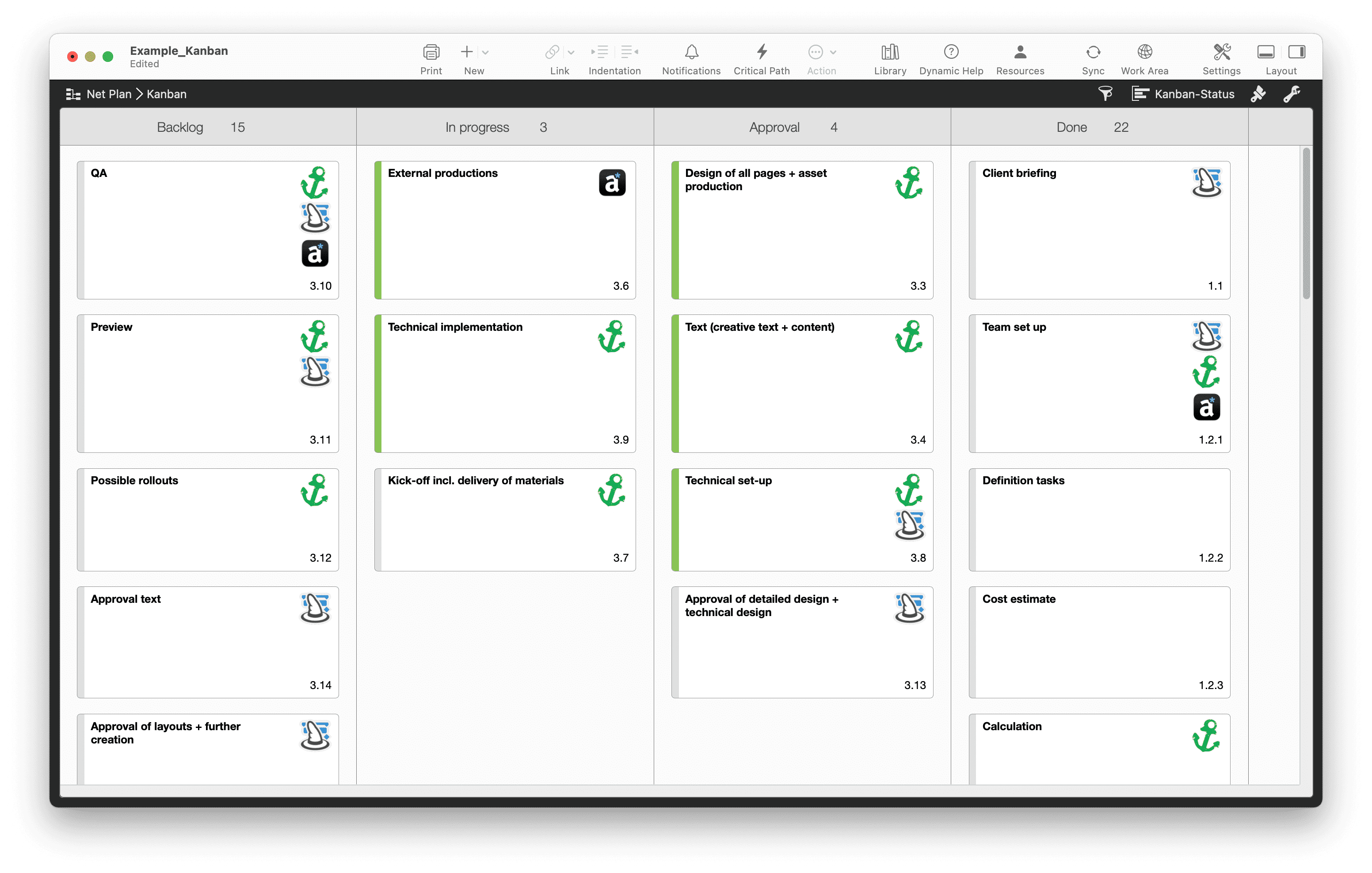
Envisagez de suivre le temps de cycle, c'est-à-dire la durée pendant laquelle une carte reste « en cours » jusqu'à ce qu'elle soit marquée « terminée ». En mesurant régulièrement ce paramètre, vous aiderez votre équipe à déterminer si les changements (comme l'abaissement des limites de l'encours ou l'adoption de nouveaux protocoles de test) accélèrent réellement la livraison. Si les durées de cycle diminuent au fil du temps, vous êtes sur la bonne voie.
Il arrive que des demandes urgentes surgissent et ne peuvent pas attendre. Décidez à l'avance de la manière dont votre équipe gère ces interruptions. Vous pouvez réserver une colonne spéciale intitulée « Accélérer », mais gardez à l'esprit une politique stricte : trop de tâches accélérées brisent votre flux normal. Une autre stratégie consiste à allouer chaque semaine une petite partie de votre capacité aux « tâches urgentes », ce qui vous permet de rester flexible sans faire dérailler le reste.
Si votre tableau commence à se sentir surchargé, (link : support/faq/pmknowledge/swimlanes text : swimlanes) (rangées horizontales) peuvent aider à catégoriser les tâches par priorité ou par type. Par exemple, un plan de travail supérieur peut être consacré aux « bogues critiques », tandis qu'un plan de travail inférieur est consacré aux « fonctionnalités régulières ». Cette approche structurée permet de s'assurer que les tâches les plus importantes ne sont pas noyées dans la masse.
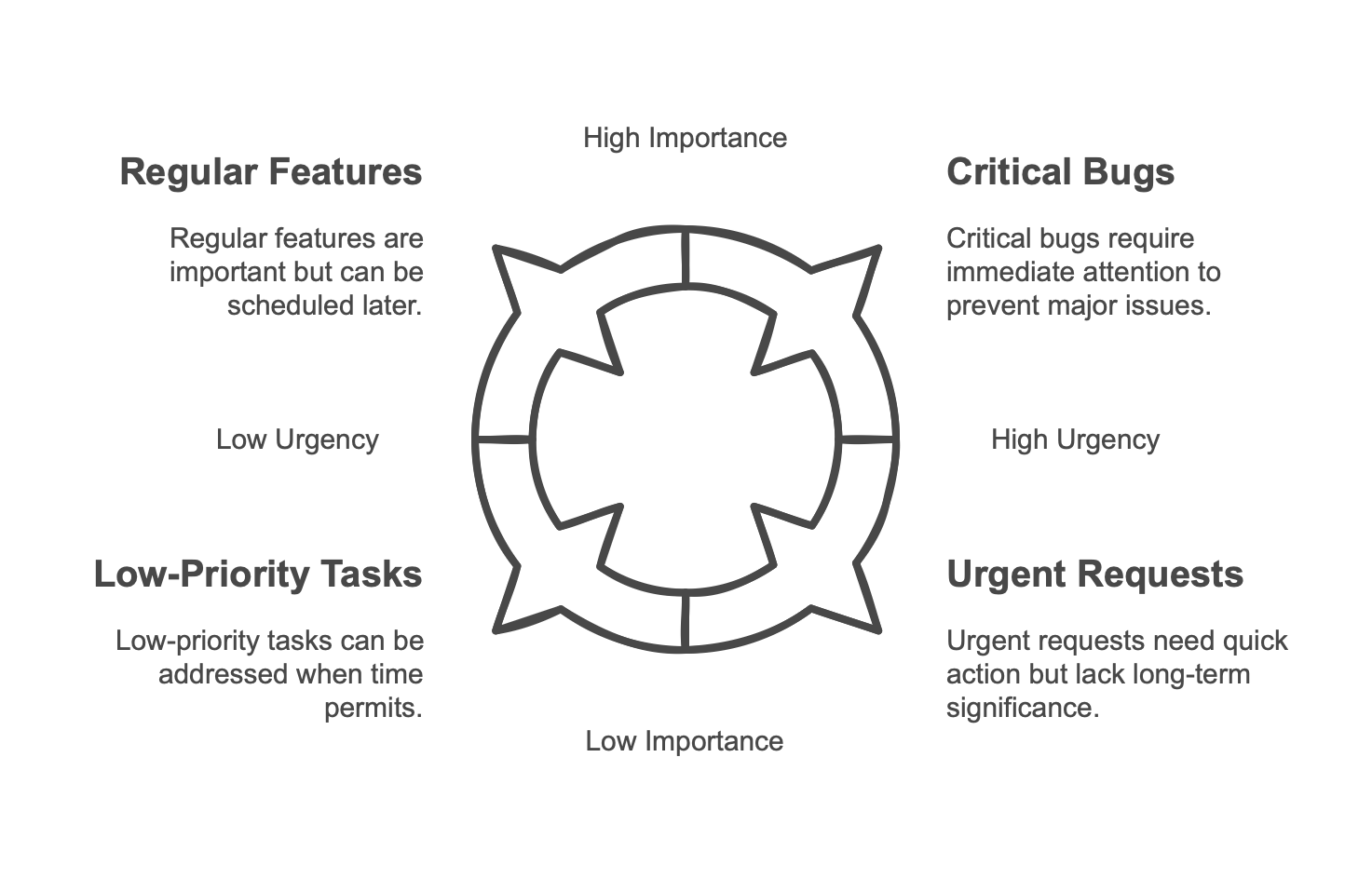
La flexibilité de Kanban lui permet de s'adapter à différents contextes :
Pour les équipes qui gèrent des flux de travail continus - comme le développement de logiciels ou la production de contenu - Kanban offre une vue partagée de l'avancement des travaux. Chaque membre voit quelles sont les tâches en cours, qui est responsable de quoi et où il pourrait avoir besoin d'aide. Les entretiens hebdomadaires ou quotidiens prennent tout leur sens, car ils portent sur des tâches visibles et des goulets d'étranglement, et non sur de vagues points.

Lorsque l'on demande aux équipes de travailler ensemble pour analyser les problèmes et concevoir des solutions, la qualité est meilleure.
David Anderson, fondateur de la méthode Kanban
Kanban peut également servir de système de liste de tâches personnelles, en particulier si vous jonglez avec plusieurs petits projets ou responsabilités. Un simple tableau à trois colonnes - To Do, Doing, Done - vous aide à voir ce qui vous attend et à éviter d'entreprendre trop de tâches à la fois. Certaines personnes utilisent même des applications Kanban numériques sur leur téléphone ou leur tablette pour suivre les tâches ménagères, la planification des repas ou les objectifs de remise en forme.
Dans les grandes organisations, les équipes mélangent souvent Kanban avec des traditional methods like la cascade ou des méthodes agiles plus structurées comme Scrum. Cette approche - parfois appelée Scrumban - vous permet de planifier des sprints ou des versions planifiées tout en continuant à utiliser un tableau Kanban pour gérer les tâches quotidiennes. Il en résulte un environnement hybride qui bénéficie des deux mondes : la prévisibilité des cycles de planification et l'adaptabilité fluide de Kanban.
| Aspect | Kanban | Scrum |
|---|---|---|
| Règles | Peu de règles fixes | Ensemble de règles complexe |
| Champ d’Application | Projets et tâches de routine (convient également aux individus) | Uniquement pour des projets (pas pour des tâches de routine) |
| Taille de l’Équipe | Peut convenir même à de très petites équipes ou à des personnes seules | Nécessite au moins trois membres dans l’équipe |
| Rôles | Aucun rôle défini | Product Owner, Scrum Master, Équipe de développement |
| Tableau | Mise à jour continue du Tableau Kanban | Le Scrum Board est réinitialisé après chaque sprint |
| Backlog | La priorisation est optionnelle | La priorisation est obligatoire |
| Itérations | Optionnelles, on peut travailler sans cycles de sprints clairement définis | Des sprints (itérations) fixes sont obligatoires |
| Taille du Projet | À partir d’une certaine envergure, Kanban peut devenir confus ; il est nécessaire de le subdiviser en unités plus petites | Grâce à son ensemble de règles structurées, Scrum peut également s’appliquer à des projets de plus grande envergure |
| Gestion du Temps | Pas de focalisation forte sur les deadlines | Les deadlines et la gestion du temps sont essentielles (par ex. via les sprints et la vélocité) |
Les tableaux Kanban peuvent être aussi simples que des notes autocollantes sur un tableau blanc ou aussi sophistiqués que des plateformes basées sur le cloud qui synchronisent les tâches à travers les zones géographiques. La meilleure approche dépend des besoins de votre équipe, de la complexité des projets et de la nécessité d'une collaboration en temps réel, d'un rapport ou d'un accès à distance.
Le choix entre un tableau Kanban physique et un tableau Kanban numérique dépend du flux de travail de votre équipe, de son style de collaboration et de son besoin de flexibilité. Voici une comparaison rapide pour vous aider à décider ce qui convient le mieux à votre projet.
Pour les équipes géographiquement dispersées, un tableau Kanban numérique est presque non négociable. Recherchez des applications dotées d'une synchronisation robuste avec le cloud, d'une édition en temps réel et de versions mobiles. Ainsi, un développeur à Singapour et un concepteur au Canada peuvent voir exactement le même tableau, sans confusion quant aux tâches en cours.
Parfois, vous avez besoin de plus qu'un tableau rapide à montrer à votre patron ou à vos clients. Les logiciels Kanban qui proposent des filtres avancés, des graphiques ou des analyses peuvent vous aider à présenter des informations fondées sur des données - comme les délais, le débit ou les taux d'erreur - sans avoir à compiler manuellement les informations à chaque fois. Les vues de type Gantt sont également pratiques pour les parties prenantes qui préfèrent les perspectives temporelles.
Les tableaux Kanban fonctionnent souvent mieux lorsqu'ils s'intègrent de manière transparente) aux calendriers, aux applications de chat ou aux plateformes spécialisées comme GitHub. De cette façon, les tâches restent synchronisées avec votre base de code ou votre calendrier d'événements, réduisant ainsi la double saisie et la confusion qui surviennent lorsque différentes parties de votre organisation vivent dans des silos numériques distincts.
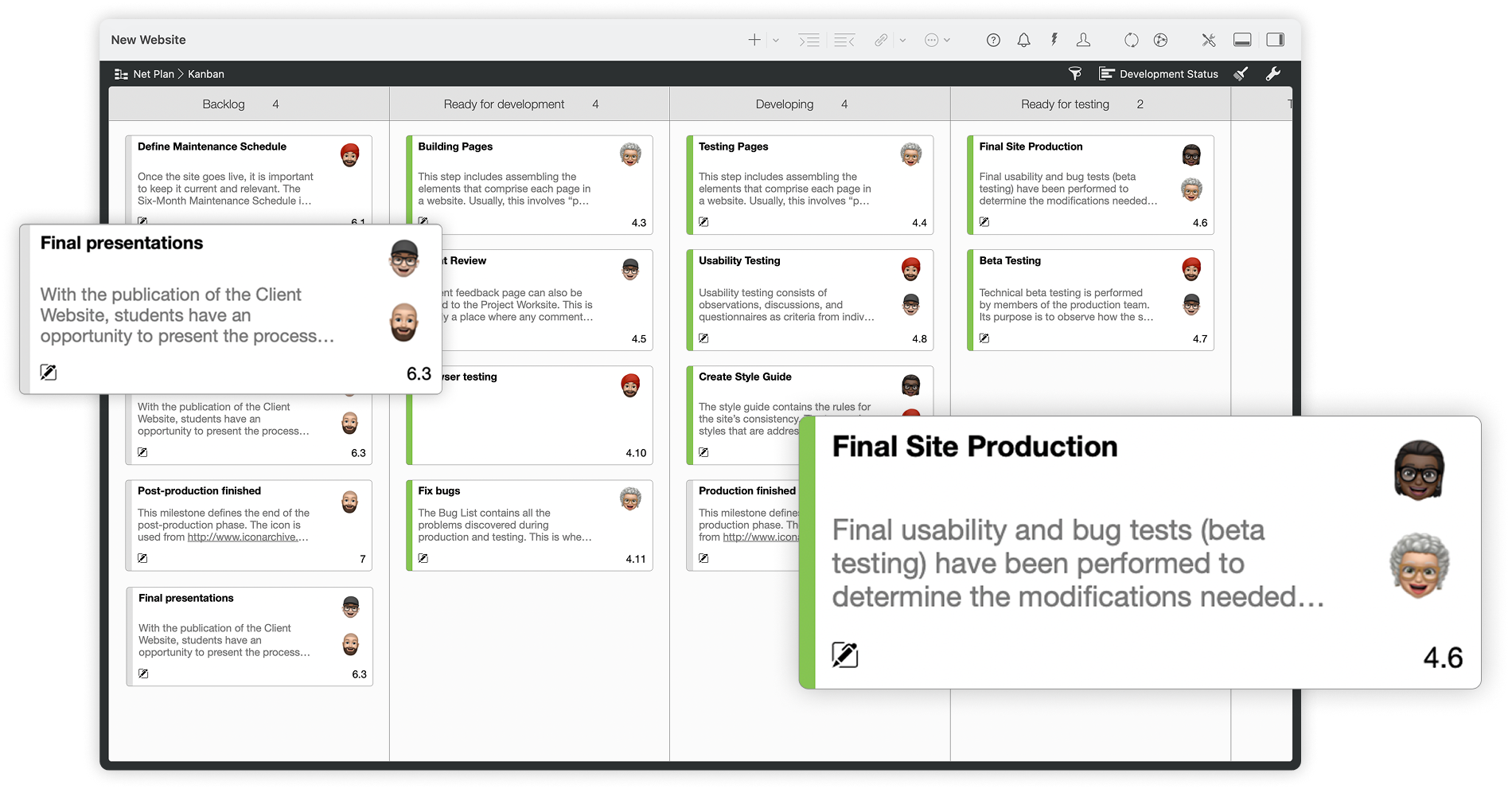
Si vous êtes à la recherche d'une solution Kanban qui s'intègre de manière transparente aux fonctionnalités traditionnelles de gestion de projet - comme les diagrammes de Gantt, l'analyse du chemin critique, la gestion des ressources et bien plus encore - ne cherchez pas plus loin que Merlin Project. Contrairement aux applications Kanban autonomes, Merlin Project vous permet d'unifier vos flux de travail agiles et traditionnels sous un même toit.
Gestion de projet agile sur macOS et iOS
Le tableau Kanban de Merlin Project offre un moyen dynamique de gérer les projets en visualisant le travail dans des colonnes structurées telles que « À faire », « En cours » et « Terminé ». Les tâches deviennent des cartes que l'on peut faire glisser, ce qui permet aux équipes de suivre les progrès, de définir des statuts personnalisés et de contrôler les limites des travaux en cours (WIP), garantissant ainsi la concentration et l'efficacité. Le tableau est entièrement synchronisé, ce qui permet à l'ensemble de l'équipe de collaborer en temps réel, les mises à jour étant instantanément répercutées pour toutes les personnes travaillant sur le projet.
Changez de méthodologie en toute transparence
Grâce à la synchronisation en temps réel entre les vues Kanban, Gantt et carte heuristique, Merlin Project vous permet de passer instantanément d'une perspective à l'autre. Commencez par réfléchir à des idées dans une carte heuristique, puis transformez-les en tableau Kanban pour la gestion des tâches ou en diagramme de Gantt pour la planification. Les colonnes personnalisées telles que « Bloqué » ou « Test » permettent d'affiner les flux de travail, tandis que les cartes de tâches prennent en charge les pièces jointes, les affectations de ressources et les commentaires, garantissant ainsi une collaboration transparente dans toutes les vues.
**Des swimlanes contre la complexité
Pour les projets complexes, les swimlanes permettent de catégoriser le travail par priorité, ensemble de fonctionnalités ou responsabilité de l'équipe, ce qui facilite la gestion de plusieurs flux de travail dans un seul projet. Le formatage avancé permet d'utiliser des cartes à code couleur et des filtres basés sur des règles pour mettre en évidence les tâches critiques, tandis que des outils de reporting transparents fournissent des informations claires sur le projet.
Kanban se distingue par sa simplicité, son adaptabilité et son focus sur l'amélioration continue. Né dans les ateliers de fabrication, mais aujourd'hui omniprésent dans les studios de design, les équipes de logiciels et même les listes de tâches personnelles, le principe de base de Kanban reste le même : visualisez votre travail, limitez votre charge de travail et améliorez sans cesse.
Que vous gériez une initiative d'entreprise tentaculaire ou vos propres projets secondaires, l'état d'esprit Kanban permet de réduire la complexité, de clarifier les priorités et d'obtenir des résultats fiables.

Le progrès ne peut être généré lorsque nous sommes satisfaits des situations existantes.
Taiichi Ohno
Vos idées, notre magie – Réalisez vos projets en toute simplicité!
Essayez maintenant gratuitement pendant 30 jours.
